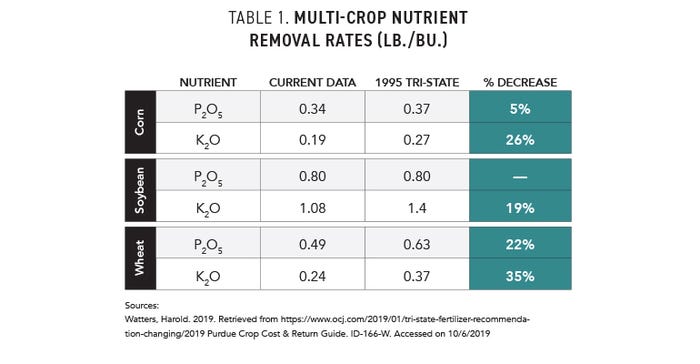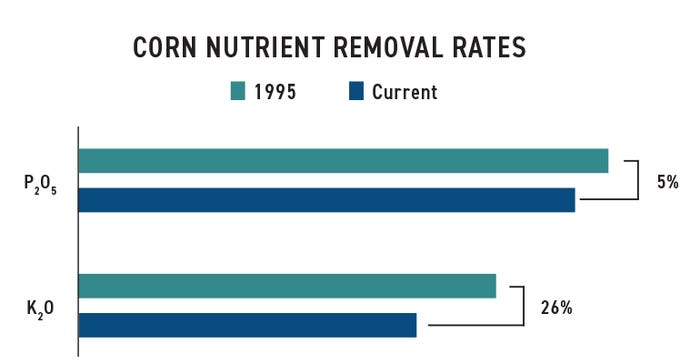December 1, 2019

Sponsored Content
What does 13 lb. of diammonium phosphate (DAP) and 27 lb. of potash mean to your operation? Out of context it probably doesn’t mean much, but what if you added it up on ever acre of corn you grow? To illustrate, on 1,000 acres of corn, that’s 6.5 tons of DAP and 13.5 tons of potash. At the time this article was written, DAP was $491/ton and potash was $387/ton. So, to answer the question, 13 lb. of DAP and 27 lb. of potash across 1,000 acres equals $8,416.00.
Now the question is where did the figures 13 and 27 come from? The Tri-State Fertilizer Recommendations for agronomic crops have changed. Academic soil and fertility scientists have tested modern corn hybrids for several years and concluded that fewer nutrients are needed to make a bushel of corn — about 5% less phosphorous and 26% less potassium, to be exact. I haven’t yet seen the updated Tri-State Fertility Recommendation, but Ohio State University Extension Agronomist, Harold Watters, shared these updated crop removal rates this past January in the Ohio County Journal as shown in Table 1.


Using Table 1., if you take the 0.03 lb. difference in P2O5 and 0.08 lb. difference in K2O across a 200 Bu./A. corn crop, you should come up with an approximate difference of 13 lb. DAP and 27 lb. potash. According to Purdue’s 2019 Crop Cost and Return Guide, corn fertilizer accounted for 31.5% of total input costs for the crop. I am not condoning cutting your fertilizer rate; however, with current commodity prices, it is advantageous to make the most of every dollar. If you can save $8,416.00 (based on 1,000 acres of corn at 200 Bu./A.), then you should.
What has changed? Modern corn hybrids are more efficient users of nutrients than hybrids used in 1995. Today’s hybrids can make more bushels with fewer nutrients- and your fertilizer budget gains the difference. But remember, it is not advised to make drastic cuts to your fertilizer plan until you have taken into account soil tests, field history, soil type and other factors.
Another update to Tri-State’s Fertility Guide is that all phosphorous and potassium recommendations will be made based on the Mehlich III extraction method. The previous guide made recommendations based on Bray P1 for phosphorous and ammonium acetate for potassium. This is important to note because the sufficient, deficient, and maintenance ranges will change. Based on Mehlich III extraction, the maintenance range for potassium is 100 to 150 ppm. Imagine squeezing an orange with your hand and measuring the average “juice per orange”, then switching to a juicing machine- the “juice per orange” would understandably change, even though the oranges themselves didn’t change. Similarly, a new extraction method will change what is a “normal” range. If you are comparing soil test values over years, be sure that you are comparing values derived from the same extraction process.
Talk with your local Beck's agronomist or representative to discuss options or scenarios that would work for your operation. For information and updates concerning the Tri-State Fertility Guide, visit SoilFertility.osu.edu.
Beck’s is the largest family-owned retail seed company in the United States that serves farmers in Illinois, Indiana, Iowa, Kentucky, Michigan, Minnesota, Missouri, Ohio, South Dakota, Tennessee, and Wisconsin. According to a recent seed industry survey, Beck’s ranks as the fourth largest corn and soybean brand in the United States. At their core, all Beck’s employees are Farmers at Heart. It stands for something special. It has soul. It has truth. And it represents a community of farmers, employees, and dealers who strive each day to seek challenges, push boundaries and innovate. Beck’s has, and always will be, proud to serve a community of farmers who love what they do and who are proud to be… Farmers at Heart. For more agronomic new and information, visit Beck’s Agronomy Talk page or blog at BecksHybrids.com
About the Author(s)
You May Also Like




